A New Approach to Determining Liquid Concentration Using Multiband Annular Ring Microwave Sensor and Polarity Correlator
Abstract
1. Introduction
- The sensor is designed so that it incorporates an annular ring resonator having inside three parallel lines, a trapezoid ground plane and a co-planar waveguide (CPW) tapered feeder, which altogether achieve multiple frequency bands to help producing changes in the frequency responses of different materials over the entire frequency range of interest of 1–6 GHz. The sensor is designed to measure the reflection coefficients to detect complex permittivity variations which is correlated to liquid concentration. Towards this objective, we prepared liquid samples (sugar plus water) with concentrations having relatively very close permittivity values, as in [26]. The reason is to have a better evaluation of the sensor’s sensitivity, and to be a step forward for future development of non-invasive blood glucose monitoring sensors, as in [24,26,27]. However, the developed sensor can be used in other sensing applications, as well.
- The signal processing technique is developed such that it applies a polarity correlator to the filtered sensor’s responses to determine liquid concentration. Note that the proposed signal processing approach is simple to implement and different from what exists in the literature, as liquid concentration is often determined by quantifying the number of shifts in resonances of a measured sensor’s responses at particular frequencies. To the best of the authors’ knowledge, this is the first time that the concentration value of a liquid has been determined using a microwave sensor complemented with a simple signal processing method based on a polarity correlator.
2. Annular Ring Microwave Sensor: Design and Analysis
3. Sensors Experimental Validation
3.1. Sample Preparation
3.2. Sensor Validation
4. Proposed Polarity Correlator for Concentration Determination
5. Conclusions
Author Contributions
Funding
Conflicts of Interest
References
- Ozturk, T. Characterization of Liquids Using Electrical Properties in Microwave and Millimeter Wave Frequency Bands. J. Nondestruct. Eval. 2019, 38, 11. [Google Scholar] [CrossRef]
- Schermer, R.T.; Stievater, T.H. Millimeter-Wave Dielectric Properties of Highly Refractive Single Crystals Characterized by Waveguide Cavity Resonance. IEEE Trans. Microw. Theory Tech. 2019, 67, 1078–1087. [Google Scholar] [CrossRef]
- Saadat-Safa, M.; Nayyeri, V.; Khanjarian, M.; Soleimani, M.; Ramahi, O.M. A CSRR-Based Sensor for Full Characterization of Magneto-Dielectric Materials. IEEE Trans. Microw. Theory Tech. 2019, 67, 806–814. [Google Scholar] [CrossRef]
- Bao, X.; Ocket, I.; Zheng, J.; Bao, J.; Zhang, M.; Kil, D.; Franssens, V.; Puers, B.; Schreurs, D.M.; Nauwelaers, B.K. Yeast Cell Growth Monitoring Using Microwave Measurements Correlated to Optical Absorbance. In Proceedings of the 2018 IEEE/MTT-S International Microwave Symposium—IMS, Philadelphia, PA, USA, 10–15 June 2018; pp. 903–906. [Google Scholar]
- Liu, W.; Xu, L.; Yang, X.; Shi, Y.; Zhan, H. Complex permittivity determination based on a radio frequency device. Sensors Actuators A Phys. 2018, 272, 75–82. [Google Scholar] [CrossRef]
- Szypłowska, A.; Lewandowski, A.; Jones, S.B.; Sabouroux, P.; Szerement, J.; Kafarski, M.; Wilczek, A.; Skierucha, W. Impact of soil salinity, texture and measurement frequency on the relations between soil moisture and 20 MHz–3 GHz dielectric permittivity spectrum for soils of medium texture. J. Hydrol. 2019, 579, 124155. [Google Scholar] [CrossRef]
- Rydosz, A.; Brudnik, A.; Staszek, K. Metal Oxide Thin Films Prepared by Magnetron Sputtering Technology for Volatile Organic Compound Detection in the Microwave Frequency Range. Materials 2019, 12, 877. [Google Scholar] [CrossRef]
- Duan, Z.; Zhao, Q.; Wang, S.; Yuan, Z.; Zhang, Y.; Li, X.; Wu, Y.; Jiang, Y.; Tai, H. Novel application of attapulgite on high performance and low-cost humidity sensors. Sens. Actuators B Chem. 2020, 305, 127534. [Google Scholar] [CrossRef]
- Goyal, R. S-parameter output from the SPICE program. IEEE Circuits Devices Mag. 1988, 4, 28–29. [Google Scholar] [CrossRef]
- Mehrotra, P.; Chatterjee, B.; Sen, S. EM-Wave Biosensors: A Review of RF, Microwave, mm-Wave and Optical Sensing. Sensors 2019, 19, 1013. [Google Scholar] [CrossRef]
- Harnsoongnoen, S. Microwave sensors based on coplanar waveguide loaded with split ring resonators: A review. Appl. Sci. Eng. Prog. 2019, 12, 224–234. [Google Scholar] [CrossRef]
- Zhang, X.; Yu, M.; Ma, Z.; Ouyang, H.; Zou, Y.; Zhang, S.L.; Niu, H.; Pan, X.; Xu, M.; Li, Z.; et al. Self-Powered Distributed Water Level Sensors Based on Liquid–Solid Triboelectric Nanogenerators for Ship Draft Detecting. Adv. Funct. Mater. 2019, 29, 1900327. [Google Scholar] [CrossRef]
- Lee, C.S.; Bai, B.; Song, Q.R.; Wang, Z.Q.; Li, G.F. Open Complementary Split-Ring Resonator Sensor for Dropping-Based Liquid Dielectric Characterization. IEEE Sens. J. 2019, 19, 11880–11890. [Google Scholar] [CrossRef]
- Zhai, L.; Liu, R.; Zhang, H.; Jin, N. Complex Admittance Detection of Horizontal Oil-Water Two-Phase Flows Using a Capacitance Sensor. IEEE Sens. J. 2019, 19, 7489–7498. [Google Scholar] [CrossRef]
- Kakani, P.N.; Chandu, D.S.; Karthikeyan, S.S. Open Complementary Split Ring Resonator Based RF Sensor with Improved Sensitivity for Detection and Estimation of Adulteration in Edible Oils. In Proceedings of the 2019 TEQIP III Sponsored International Conference on Microwave Integrated Circuits, Photonics and Wireless Networks (IMICPW), Tiruchirappalli, India, 22–24 May 2019; pp. 479–482. [Google Scholar]
- Ejaz, T.; Sami, A.; Mughal, M.A.; Rahman, H.U. Volume Fraction Extraction for Binary Mixture of Ethanol and Methanol Using Optimized Microwave Microfluidic Sensor. Prog. Electromagn. Res. M 2019, 87, 43–52. [Google Scholar] [CrossRef]
- Khanna, Y.; Awasthi, Y.K. Dual-Band Microwave Sensor for Investigation of Liquid Impurity Concentration Using a Metamaterial Complementary Split-Ring Resonator. J. Electron. Mater. 2020, 49, 385–394. [Google Scholar] [CrossRef]
- Iqbal, A.; Smida, A.; Saraereh, O.A.; Alsafasfeh, Q.H.; Mallat, N.K.; Lee, B.M. Cylindrical dielectric resonator antenna-based sensors for liquid chemical detection. Sensors 2019, 19, 1200. [Google Scholar] [CrossRef]
- Aloui, R.; Houaneb, Z.; Zairi, H. Substrate Integrated Waveguide Circular Antenna for Terahertz Application. Prog. Electromagn. Res. C 2019, 96, 229–242. [Google Scholar] [CrossRef]
- Jankovic, N.; Radonic, V. A microwave microfluidic sensor based on a dual-mode resonator for dual-sensing applications. Sensors 2017, 17, 2713. [Google Scholar] [CrossRef]
- Seo, Y.; Memon, M.U.; Lim, S. Microfluidic Eighth-Mode Substrate-Integrated-Waveguide Antenna for Compact Ethanol Chemical Sensor Application. IEEE Trans. Antennas Propag. 2016, 64, 3218–3222. [Google Scholar] [CrossRef]
- Gholamian, M.; Shabanpour, J.; Cheldavi, A. Highly sensitive quarter-mode spoof localized plasmonic resonator for dual-detection RF microfluidic chemical sensor. J. Phys. D Appl. Phys. 2020, 53, 145401. [Google Scholar] [CrossRef]
- George, J.; Abdelghani, A.; Bahoumina, P.; Tantot, O.; Baillargeat, D.; Frigui, K.; Dejous, C. CNT-Based Inkjet-Printed RF Gas Sensor: Modification of Substrate Properties during the Fabrication Process. Sensors 2019, 19, 1768. [Google Scholar] [CrossRef] [PubMed]
- Villena Gonzales, W.; Mobashsher, A.T.; Abbosh, A. The progress of glucose monitoring—A review of invasive to minimally and non-invasive techniques. Devices Sens. 2019, 19, 800. [Google Scholar] [CrossRef] [PubMed]
- Kiani, S.; Rezaei, P.; Navaei, M. Dual-sensing and dual-frequency microwave SRR sensor for liquid samples permittivity detection. Measurement 2020, 160, 107805. [Google Scholar] [CrossRef]
- Sethi, W.T.; Issa, K.; Ashraf, M.A.; Alshebeili, S. In vitro analysis of a microwave sensor for noninvasive glucose monitoring. Microw Opt. Technol. Lett. 2019, 61, 599–604. [Google Scholar] [CrossRef]
- Cappon, G.; Vettoretti, M.; Sparacino, G.; Facchinetti, A. Continuous glucose monitoring sensors for diabetes management: A review of technologies and applications. Diabetes Metab. J. 2019, 43, 383–397. [Google Scholar] [CrossRef]
- Ebrahimi, A.; Scott, J.; Ghorbani, K. Microwave reflective biosensor for glucose level detection in aqueous solutions. Sens. Actuators A Phys. 2020, 301, 111662. [Google Scholar] [CrossRef]
- Govind, G.; Akhtar, M.J. Metamaterial-Inspired Microwave Microfluidic Sensor for Glucose Monitoring in Aqueous Solutions. IEEE Sens. J. 2019, 19, 11900–11907. [Google Scholar] [CrossRef]
- Odabashyan, L.; Babajanyan, A.; Baghdasaryan, Z.; Kim, S.; Kim, J.; Friedman, B.; Lee, J.H.; Lee, K. Real-Time Noninvasive Measurement of Glucose Concentration Using a Modified Hilbert Shaped Microwave Sensor. Sensors 2019, 19, 5525. [Google Scholar] [CrossRef]
- Abedeen, Z.; Poonam, A. Microwave sensing technique based label-free and real-time planar glucose analyzer fabricated on FR4. Sens. Actuators A Phys. 2018, 279, 132–139. [Google Scholar] [CrossRef]
- Vélez, P.; Muñoz, J.; Mata-Contreras, J.; Dubuc, D.; Grenier, K.; Martin, F. Measuring Glucose Content in Aqueous Solutions by means of Split Ring Resonator (SRR) Loaded Transmission Lines. In Proceedings of the 12th International Congress on Artificial Materials for Novel Wave Phenomena (Metamaterials), Espoo, Finland, 27 August–1 September 2018; pp. 418–420. [Google Scholar] [CrossRef]
- Omkar; Yu, W.; Huang, S.Y. T-Shaped Patterned Microstrip Line for Noninvasive Continuous Glucose Sensing. IEEE Microw. Wirel. Compon. Lett. 2018, 28, 942–944. [Google Scholar] [CrossRef]
- Harnsoongnoen, S.; Wanthong, A. Coplanar waveguide transmission line loaded with electric-LC resonator for determination of glucose concentration sensing. IEEE Sens. J. 2017, 17, 1635–1640. [Google Scholar] [CrossRef]
- Kandoian, A.G. Broad Band Antenna. U.S. Patent No. 2,368,663, 6 February 1945. [Google Scholar]
- Agrawall, N.P.; Kumar, G.; Ray, K.P. Wide-band planar monopole antennas. IEEE Trans. Antennas Propag. 1998, 46, 294–295. [Google Scholar] [CrossRef]
- Computer Simulation Technology Version 2019. Available online: https://www.3ds.com/products-services/simulia/products/cst-studio-suite/ (accessed on 10 October 2019).
- Microwave Network Analyzer N5227A. Available online: https://www.keysight.com/en/pdx-x201878-pn-N5227A/pna-microwave-network-analyzer-67-ghz?cc=PK&lc=eng (accessed on 25 May 2020).
- Park, S.J.; Cunningham, J. Determination of Permittivity of Dielectric Analytes in the Terahertz Frequency Range Using Split Ring Resonator Elements Integrated with On-Chip Waveguide. Sensors 2020, 20, 4264. [Google Scholar] [CrossRef] [PubMed]
- Rechberger, W.; Hohenau, A.; Leitner, A.; Krenn, J.R.; Lamprecht, B.; Aussenegg, F.R. Optical properties of two interacting gold nanoparticles. Opt. Commun. 2003, 220, 137–141. [Google Scholar] [CrossRef]
- Gubbiotti, G.; Malagò, P.; Fin, S.; Tacchi, S.; Giovannini, L.; Bisero, D.; Madami, M.; Carlotti, G.; Ding, J.; Adeyeye, A.O.; et al. Magnetic normal modes of bicomponent permalloy/cobalt structures in the parallel and antiparallel ground state. Phys. Rev. B 2014, 90, 024419. [Google Scholar] [CrossRef]
- Sun, Y.; Tong, Y.W.; Xue, C.H.; Ding, Y.Q.; Li, Y.H.; Jiang, H.; Chen, H. Electromagnetic diode based on nonlinear electromagnetically induced transparency in metamaterials. Appl. Phys. Lett. 2013, 103, 091904. [Google Scholar] [CrossRef]
- Vashist, S.; Luong, J.H. Non-invasive analytics for point-of-care testing of glucose. In Point-of-Care Glucose Detection for Diabetic Monitoring and Management; CRC Press: Boca Raton, FL, USA, 2017; pp. 59–84. [Google Scholar]
- Dielectric Assessment Kit from Speag. Available online: https://www.speag.com/products/dak/dielectric-measurements/ (accessed on 10 July 2020).
- Loba Chemie: Laboratory Chemicals, Laboratory Reagents, Dextrose Organic Reagents. 2018. Available online: https://www.lobachemie.com/Carbohydrates-03169/DEXTROSE-ANHYDROUS-CASNO-50-99-7.aspx?search=dextrose (accessed on 11 June 2020).
- RCT Basic. IKA. 2018. Available online: https://www.ika.com (accessed on 15 June 2020).
- LPKF E33 Prototyping and Etching Machine. Available online: https://www.lpkfusa.com/products/pcb_prototyping/machines/protomat_e33/ (accessed on 25 May 2020).
- Boashash, B. Time-Frequency Signal Analysis and Processing: A Comprehensive Reference; Academic: San Francisco, CA, USA, 2015. [Google Scholar]
- Koohestani, M.; Moreira, A.A.; Skrivervik, A.K. Fidelity concepts used in UWB systems. In Proceedings of the 2014 IEEE Antennas and Propagation Society International Symposium (APSURSI), Memphis, TN, USA, 6–11 July 2014; pp. 824–825. [Google Scholar]
- Hu, S.; Law, C.L.; Dou, W. A balloon-shaped monopole antenna for passive UWB-RFID tag applications. IEEE Antennas Wirel. Propag. Lett. 2008, 7, 366–368. [Google Scholar]
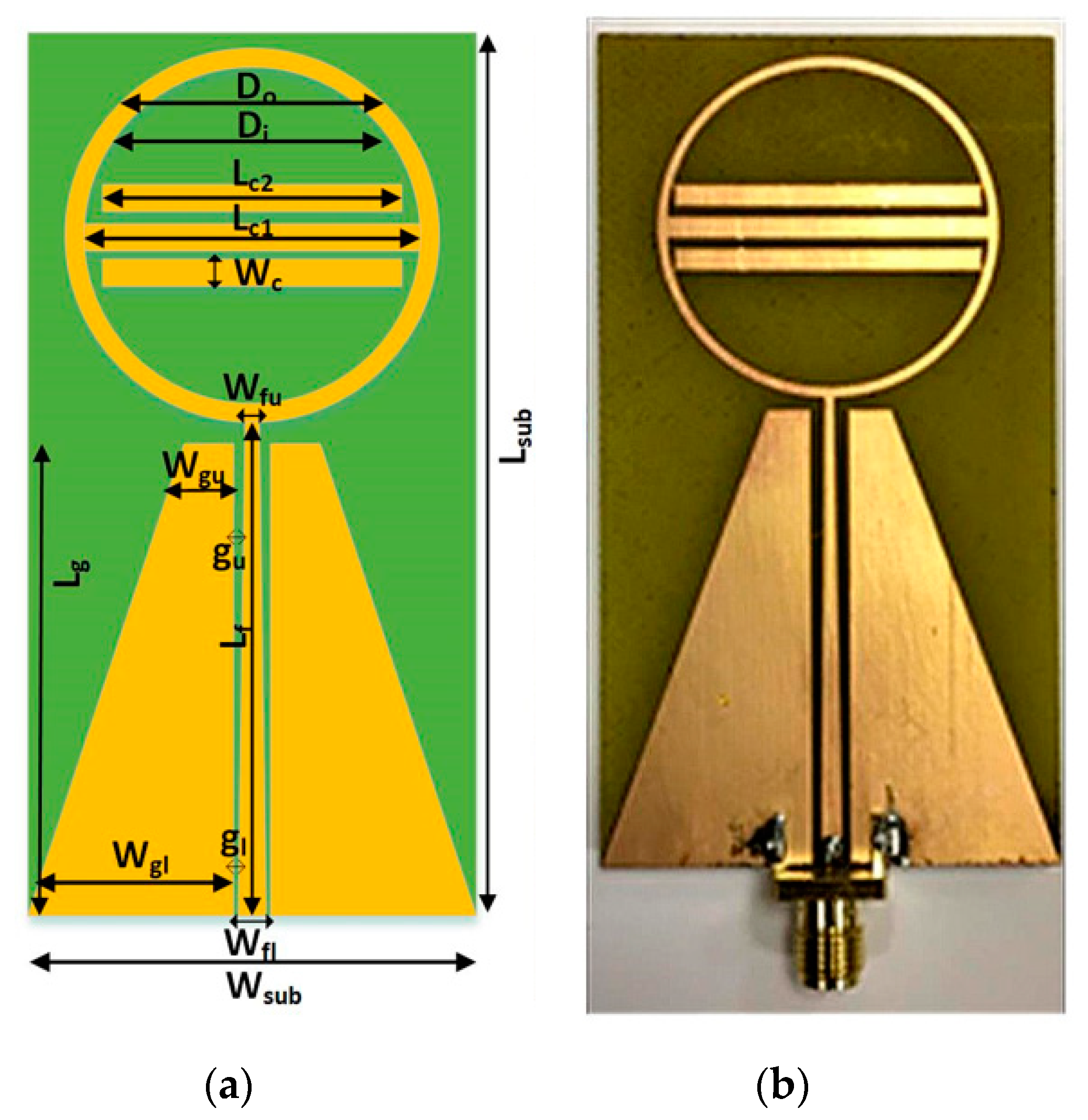
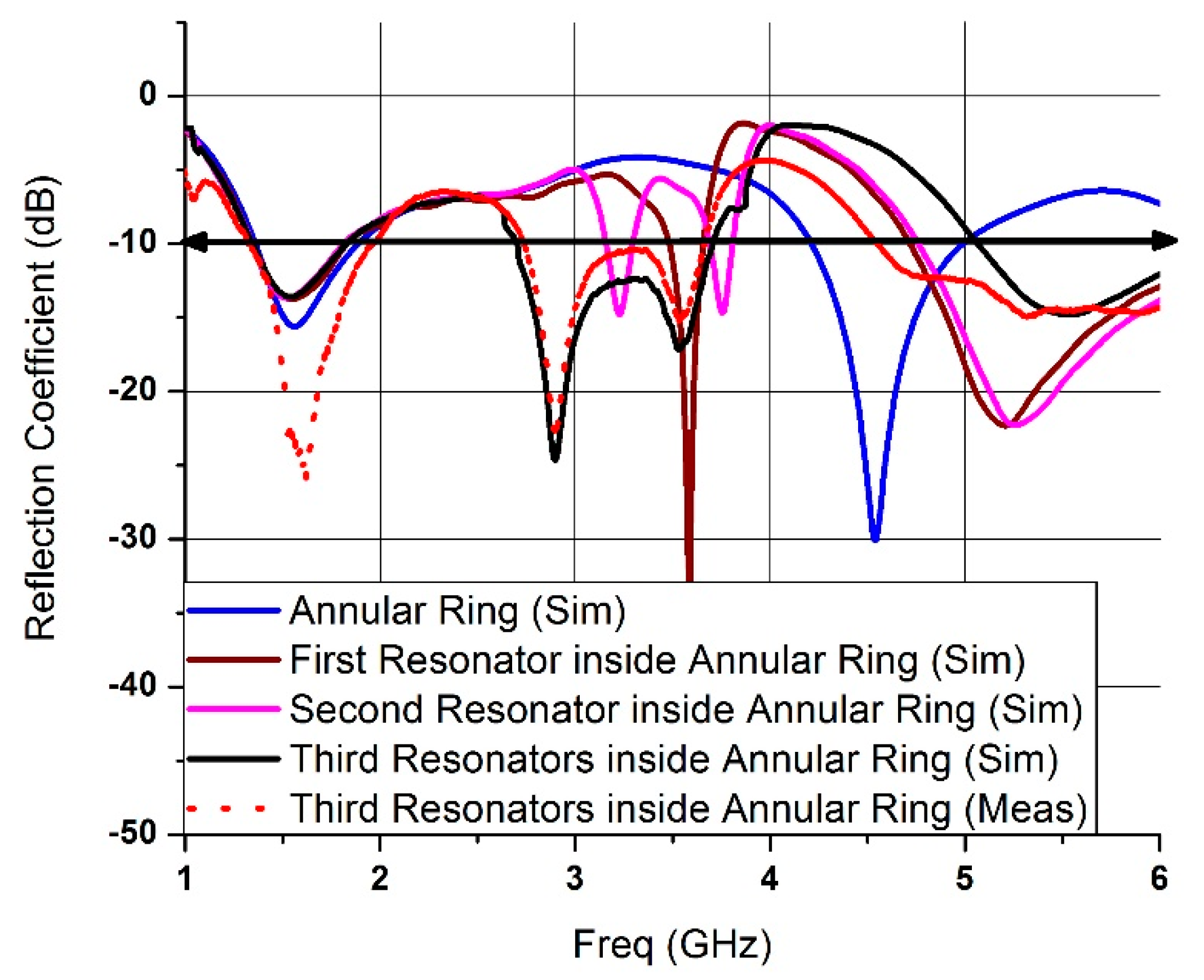
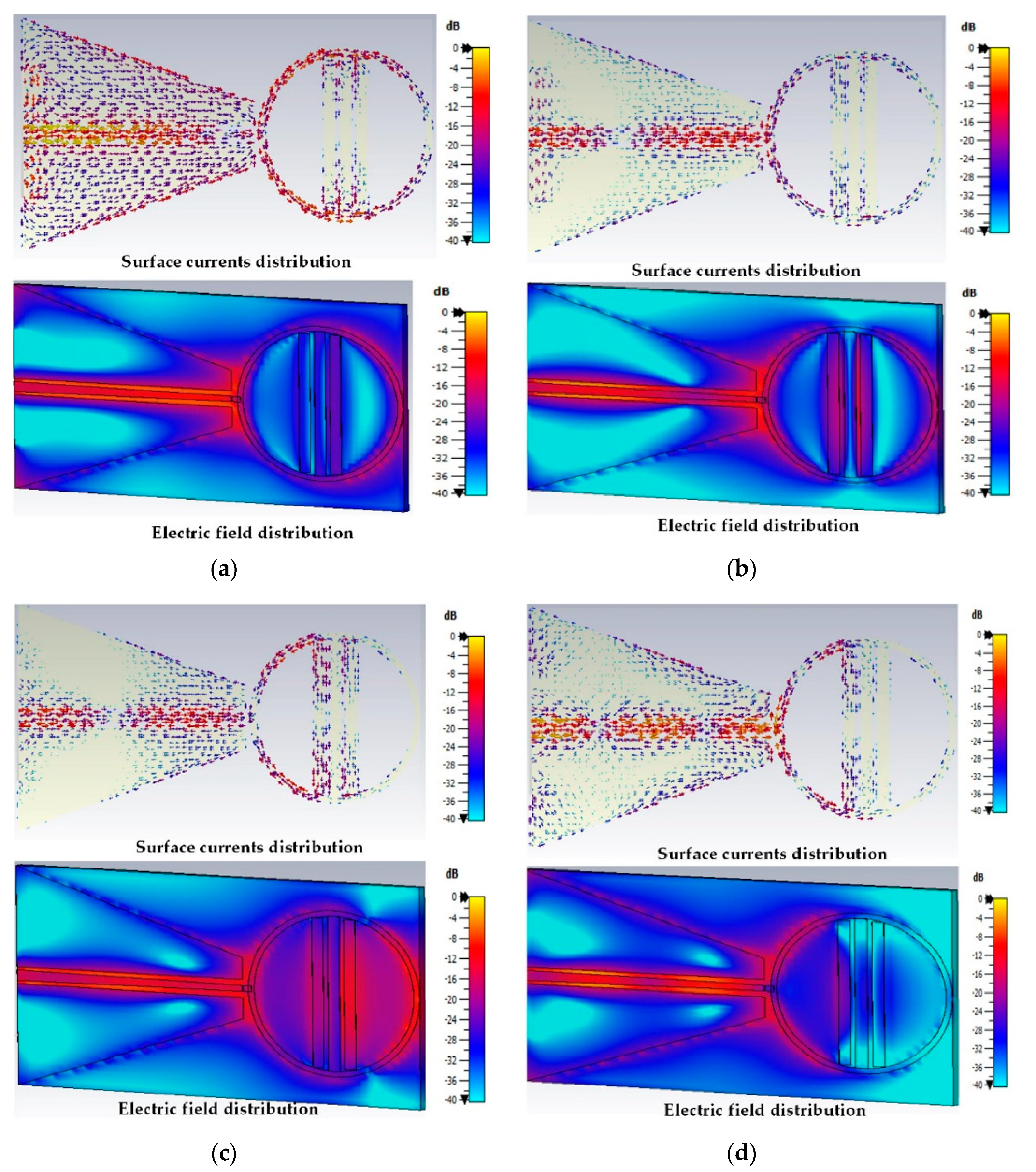

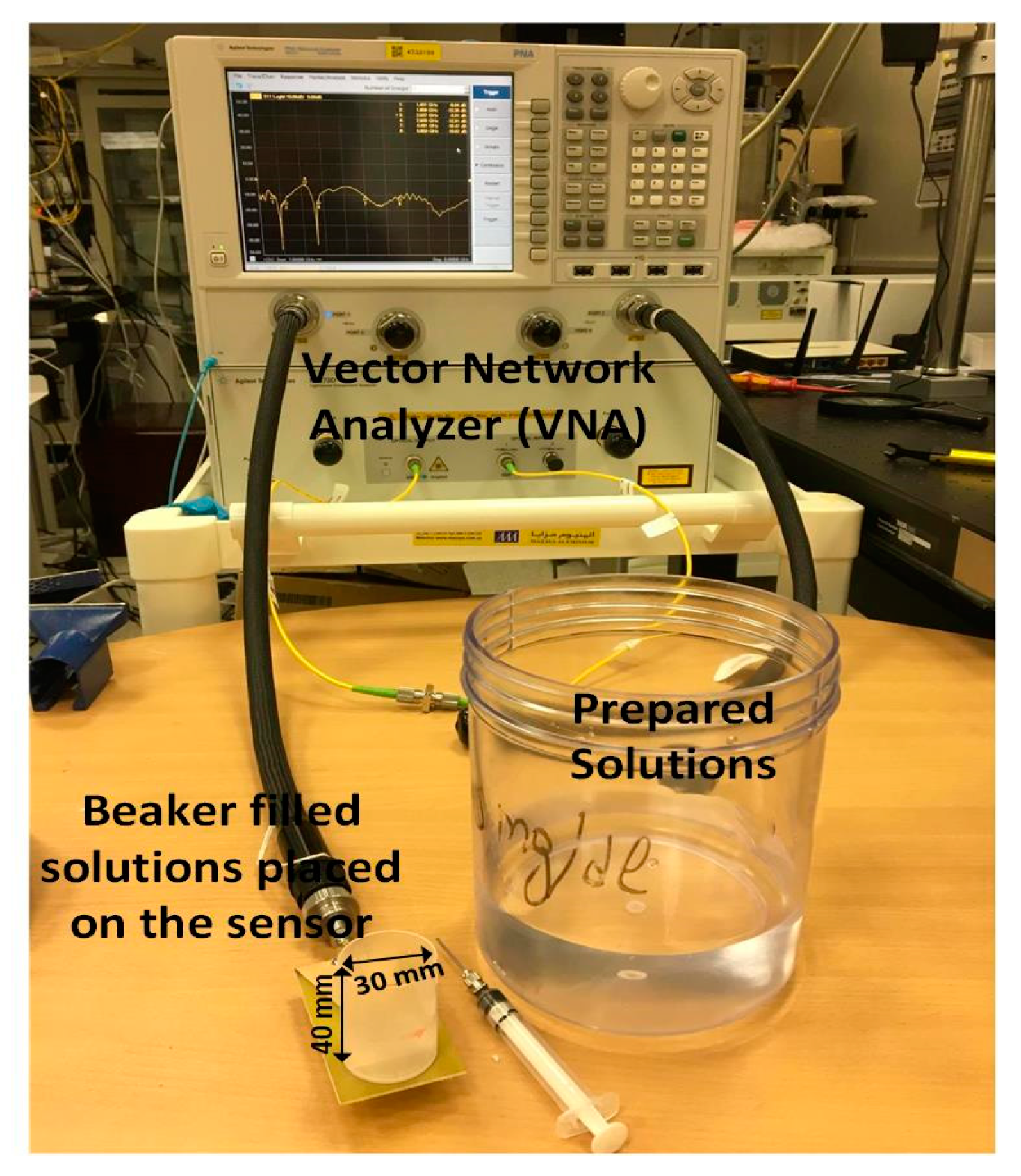
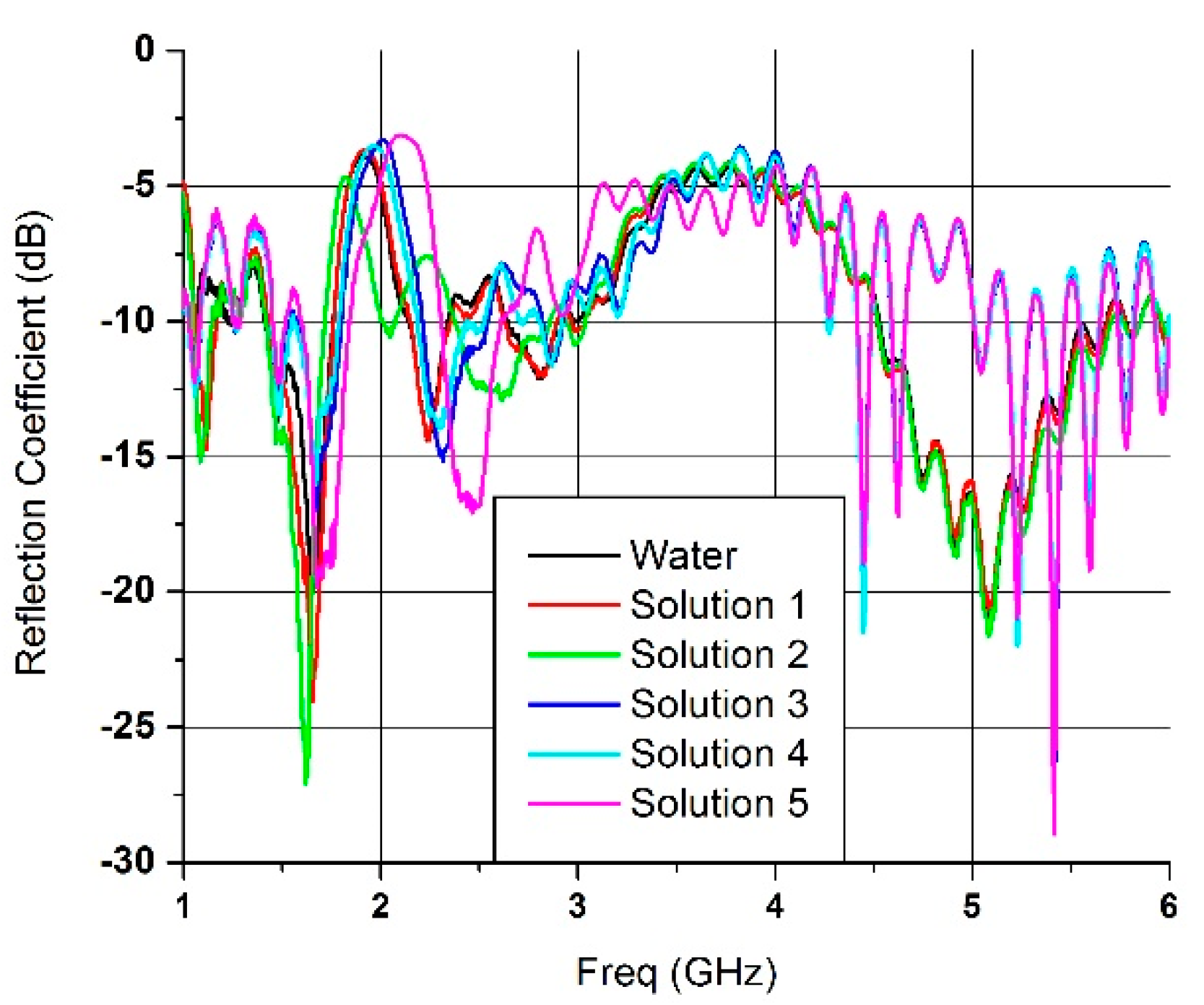
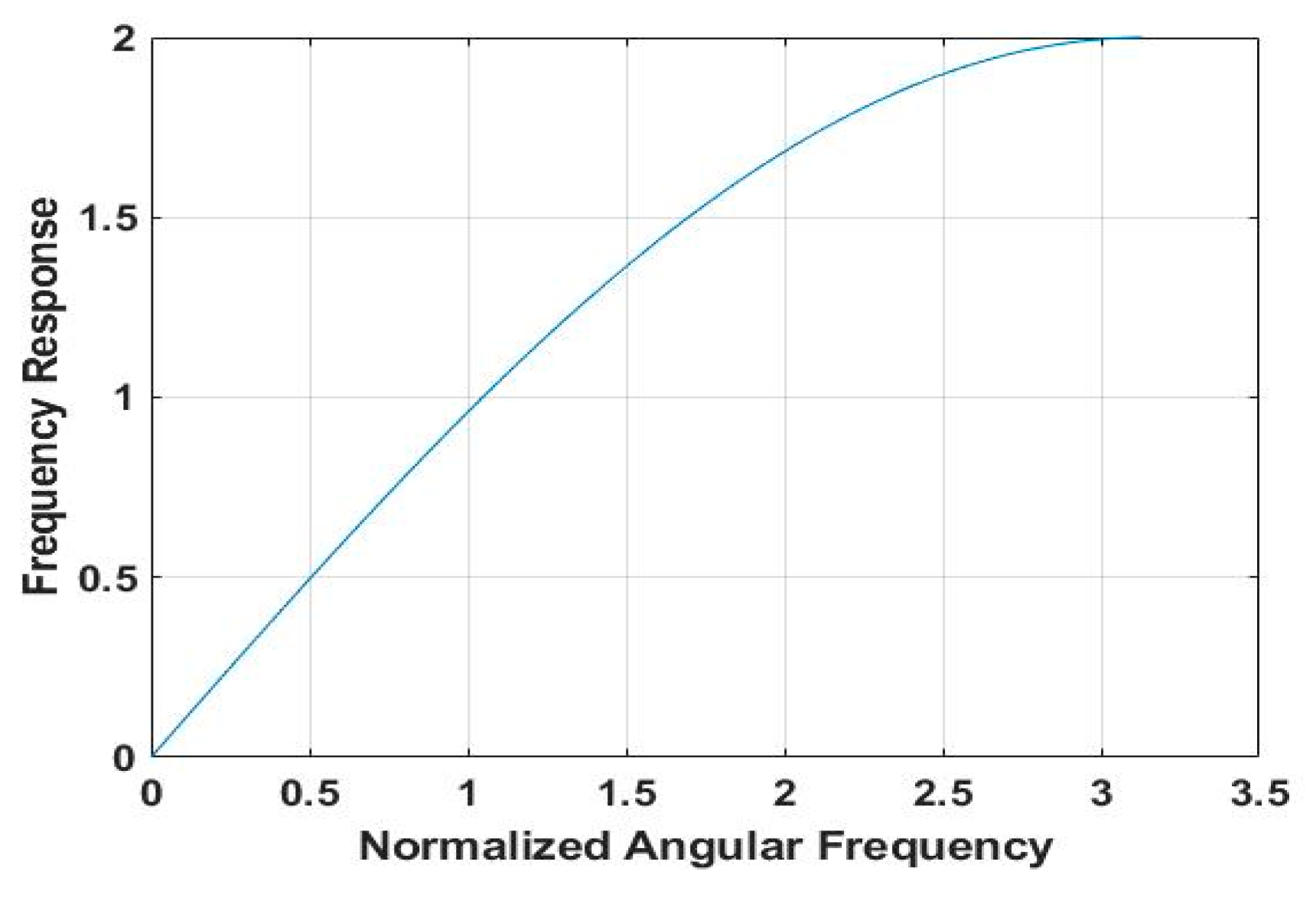
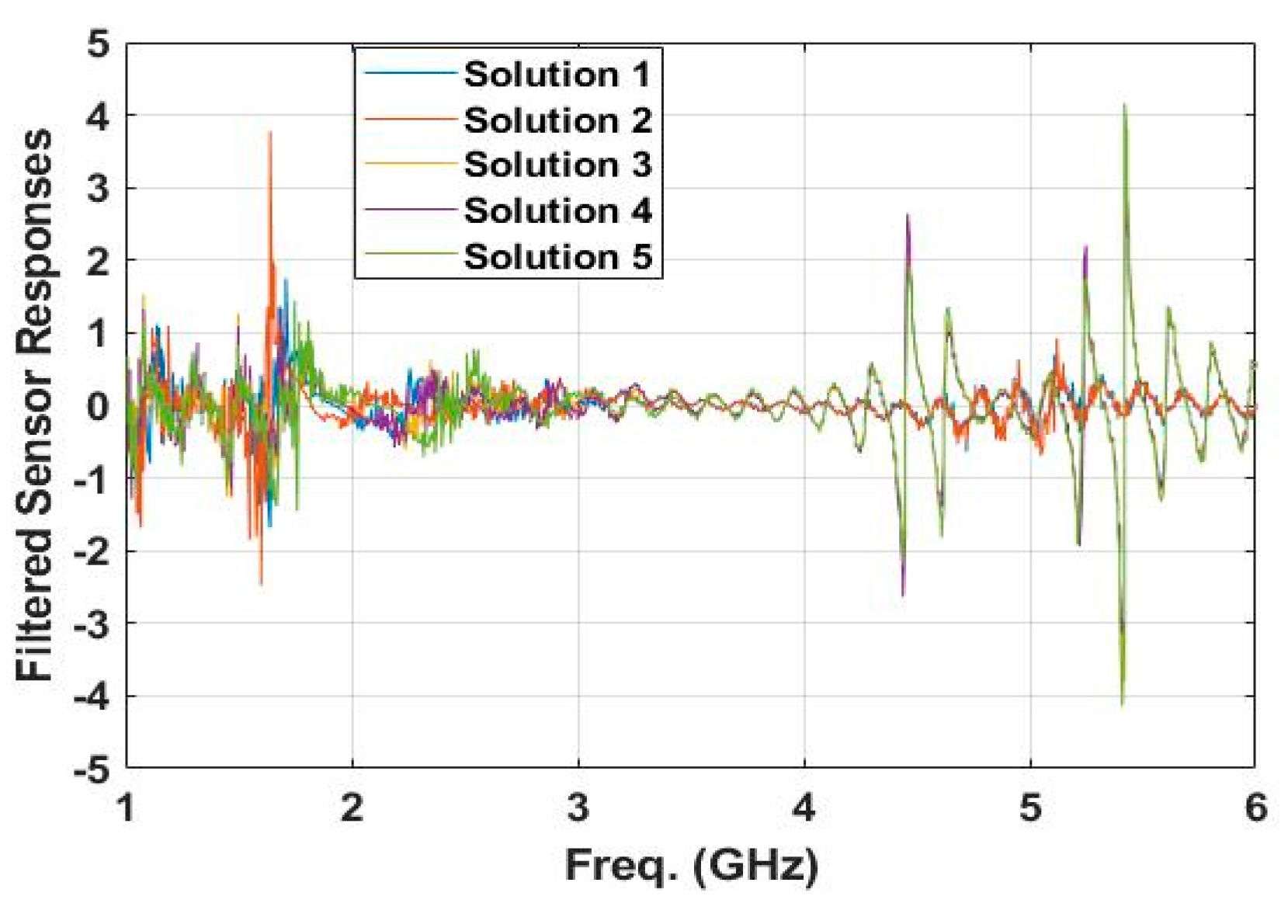

| Reference | Sensor Structure | Frequency Bands (GHz) | Concentrations mg/dL | No. of Ports |
|---|---|---|---|---|
| [28] | CSRR | Single (2.5) | 500, 2000, 4000, 6000, 8000 | 1 |
| [29] | SRR | Single (4.2) | 0, 1250, 2083, 3571, 5000 | 2 |
| [30] | Hilbert shaped resonator | Single (6) | 50, 100, 150, 200, 250 | 2 |
| [31] | CPW IDT | Single (4) | 10,000, 20,000, 100,000 | 2 |
| [32] | SRR-loaded lines | Single (0.95) | 250, 500, 1000, 2000, 4000, 6000 | 2 |
| [33] | Microstrip Line | Wideband (6–7.8) | 100–600 | 1 |
| [34] | CPW T-Line loaded with LC resonator | Wideband (2.5–6 GHz) | 4000, 8000, 12,000, 16,000, 20,000 | 2 |
| This work | Annular ring resonator | Wideband (1–6) | 60, 100, 160, 180, 200 | 1 |
| Parameter | Value (mm) |
|---|---|
| Inner Diameter, Di | 28 |
| Outer Diameter, Do | 30 |
| Resonator Length, Lc1 | 28 |
| Resonator Length, Lc2 | 27 |
| Resonators Width, Wc | 2 |
| Feed Width Lower, Wfl | 2.38 |
| Feed Width Upper, Wfu | 1 |
| Feed Length, Lf | 40 |
| Ground Length, Lg | 40 |
| Ground Width Upper, Wgu | 4 |
| Ground Width Lower, Wgl | 18.8 |
| Gap Lower, gl | 0.3 |
| Gap Upper, gu | 1 |
| Substrate Length, Lsub | 71 |
| Substrate Width, Wsub | 40 |
| Substrate Height | 1.6 |
| Fidelity Factor (pij) | i | |||||
|---|---|---|---|---|---|---|
| j | 1 | 2 | 3 | 4 | 5 | |
| 1 | 1 | 0.9871 | 0.9375 | 0.9412 | 0.9160 | |
| 2 | 0.9871 | 1 | 0.9191 | 0.9233 | 0.9056 | |
| 3 | 0.9375 | 0.9191 | 1 | 0.9983 | 0.9781 | |
| 4 | 0.9412 | 0.9233 | 0.9983 | 1 | 0.9705 | |
| 5 | 0.9160 | 0.9056 | 0.9781 | 0.9705 | 1 | |
| Fidelity Factor (pij) | i | |||||
|---|---|---|---|---|---|---|
| j | 1 | 2 | 3 | 4 | 5 | |
| 1 | 1 | 0.5330 | 0.2332 | 0.2290 | 0.2414 | |
| 2 | 0.5330 | 1 | 0.2251 | 0.2132 | 0.2429 | |
| 3 | 0.2332 | 0.2251 | 1 | 0.9728 | 0.9240 | |
| 4 | 0.2290 | 0.2131 | 0.9728 | 1 | 0.9010 | |
| 5 | 0.2414 | 0.2429 | 0.9240 | 0.9010 | 1 | |
| Fidelity Factor (pij) | i | |||||
|---|---|---|---|---|---|---|
| j | 1 | 2 | 3 | 4 | 5 | |
| 1 | 1 | 0.4983 | 0.2722 | 0.2913 | 0.2925 | |
| 2 | 0.4983 | 1 | 0.3048 | 0.2846 | 0.2790 | |
| 3 | 0.2722 | 0.3048 | 1 | 0.8425 | 0.7030 | |
| 4 | 0.2913 | 0.2846 | 0.8425 | 1 | 0.6715 | |
| 5 | 0.2925 | 0.2790 | 0.7030 | 0.6715 | 1 | |
© 2020 by the authors. Licensee MDPI, Basel, Switzerland. This article is an open access article distributed under the terms and conditions of the Creative Commons Attribution (CC BY) license (http://creativecommons.org/licenses/by/4.0/).
Share and Cite
Sethi, W.; Ibrahim, A.; Issa, K.; Albishi, A.; Alshebeili, S. A New Approach to Determining Liquid Concentration Using Multiband Annular Ring Microwave Sensor and Polarity Correlator. Electronics 2020, 9, 1616. https://doi.org/10.3390/electronics9101616
Sethi W, Ibrahim A, Issa K, Albishi A, Alshebeili S. A New Approach to Determining Liquid Concentration Using Multiband Annular Ring Microwave Sensor and Polarity Correlator. Electronics. 2020; 9(10):1616. https://doi.org/10.3390/electronics9101616
Chicago/Turabian StyleSethi, Waleed, Ahmed Ibrahim, Khaled Issa, Ali Albishi, and Saleh Alshebeili. 2020. "A New Approach to Determining Liquid Concentration Using Multiband Annular Ring Microwave Sensor and Polarity Correlator" Electronics 9, no. 10: 1616. https://doi.org/10.3390/electronics9101616
APA StyleSethi, W., Ibrahim, A., Issa, K., Albishi, A., & Alshebeili, S. (2020). A New Approach to Determining Liquid Concentration Using Multiband Annular Ring Microwave Sensor and Polarity Correlator. Electronics, 9(10), 1616. https://doi.org/10.3390/electronics9101616






